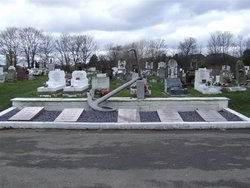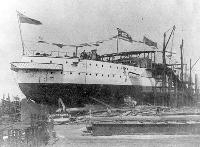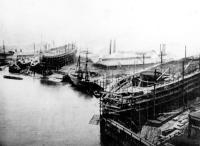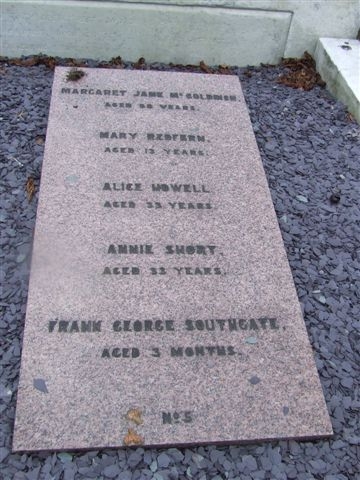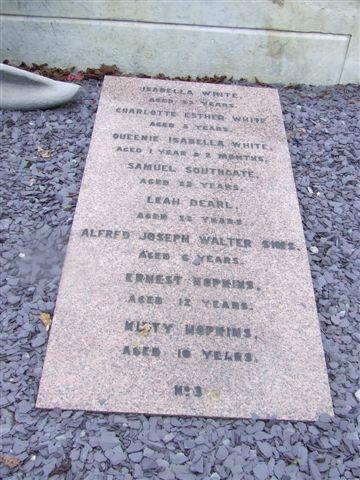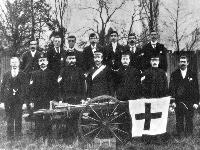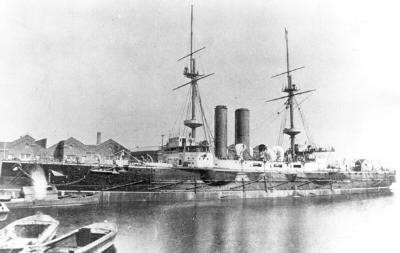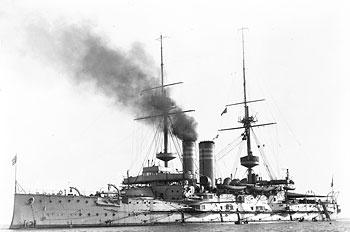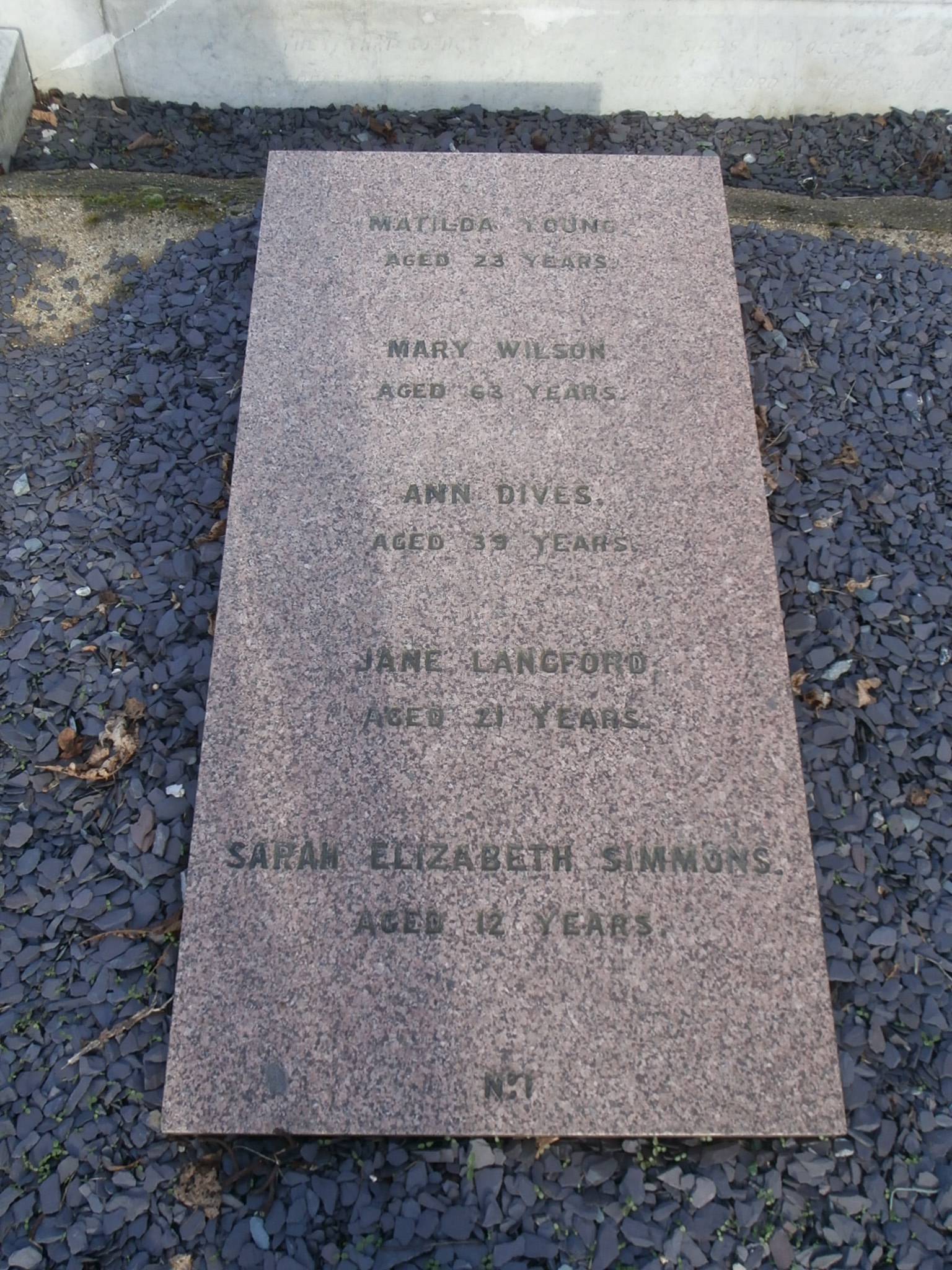The 'Albion' was a first-class battleship of around 390ft in length and 74ft in width. She had a displacement of 13,150 tons when fitted out. The Admiralty commissioned her from the Thames Ironworks at the height of the Anglo-German naval arms race. Work on the ship had been delayed partly because the yard was undermanned and also because the 1898 engineering strike had put contractors behind in their deliveries of parts.
Eventually the work was completed and the Albion was ready for launch. But at 6000 tons, she was less than her intended weight. This was because the contractors did not supply enough armour plating to clad the ship.
The launch took place on 21 June 1898. Around 30,000 spectators had crammed into the shipyard to watch the launch by the Duchess of York. Yard workers and local schools were given the day off.
Up to 200 people, keen to get a good view, had made their way to a temporary slipway 'bridge'. This was next to a nearly completed vessel, the Shikishima, being built for the Japanese navy. The bridge was not designed to hold so many, and in fact, was signposted as dangerous. But a large crowd had gathered, ignoring the warnings from yard workers and police.
The width of the Thames at Bow Creek was relatively narrow. As a result the larger vessels were built parallel to the shore and launched sideways into the water. This was to be the case with the launch of the Albion.
After three failed attempts to smash a bottle of champagne against the hull, the Duchess cut the cord. This signalled to workmen to release the dogstores holding the Albion.
The momentum of the vessel's launch created a large wave. This raced along and engulfed the bridge, smashing it to pieces and plunging onlookers into the river. Many were killed and injured. Their cries of panic were drowned out by the cheers of the main crowd applauding the launch. The Duke and Duchess, unaware of any problem, returned to their own boat and the crowds began to move away.
It was at least 10 minutes before news of the accident came through to the yard managers, although spectators and workers nearby had begun immediate rescue efforts. Onlookers dived into the muddy waters to help the survivors.
The Thames police used rowing boats to rescue people and the ironworks ambulance corps was soon on the scene. Despite their best efforts, 38 people, including women and children, died in the incident.
Arnold Hills, the Chairman of the works, was devastated by the disaster. In the following days he visited the families of the bereaved.
Hills promised to meet all funeral expenses and contributed to a fund set up by West Ham Council to help the survivors. Many of the dead were among the poorest people in London.
Most of the dead were buried in a communal grave at East London Cemetery the week after the accident. Huge crowds gathered along the routes of the funeral processions. Mrs Eliza Tarbot was the oldest victim at 64 and she was first to be buried.
Mrs Tarbot was followed by Mrs Isabel White, 30, and her two children, Lottie, five, and Queenie, two. When Mrs White was pulled out of the water, rescuers found her daughters still clinging to her frock. All were drowned.
As for the Albion, she served in the Middle East during World War I before being sold for scrap in December 1918.
In grave 1 rest:
Matilda Young 23
Mary Wilson 63
Ann Dives 39
Jane Langford 21
Sarah Elizabeth Simmons 12
In grave 2 rest:
John Petty 21
Ada Jane King 23
Rose Lucetta Elliott 17
Moses Jethro James 14
George Claydon 14
In grave 3 rest:
Isabella White 33
Charlotte Esther White 5
Queenie Isabella White 1
Samuel Southgate 23
Leah Dearl 23
Alfred Joseph Walter Sims 6
Ernest Hopkins 12
Kitty Hopkins 10
In grave 4
William Riley 11
Beatrice Bishop 24
Sarah Ann Whitehouse 21
Mary Ann Eve 48
Eliza Eleanor Tarbox 64
In grave 5
Margaret Jane McGoldrick 38
Mary Redfern 13
Alice Howell 33
Annie Short 33
Frank George Southgate 3 months
The 'Albion' was a first-class battleship of around 390ft in length and 74ft in width. She had a displacement of 13,150 tons when fitted out. The Admiralty commissioned her from the Thames Ironworks at the height of the Anglo-German naval arms race. Work on the ship had been delayed partly because the yard was undermanned and also because the 1898 engineering strike had put contractors behind in their deliveries of parts.
Eventually the work was completed and the Albion was ready for launch. But at 6000 tons, she was less than her intended weight. This was because the contractors did not supply enough armour plating to clad the ship.
The launch took place on 21 June 1898. Around 30,000 spectators had crammed into the shipyard to watch the launch by the Duchess of York. Yard workers and local schools were given the day off.
Up to 200 people, keen to get a good view, had made their way to a temporary slipway 'bridge'. This was next to a nearly completed vessel, the Shikishima, being built for the Japanese navy. The bridge was not designed to hold so many, and in fact, was signposted as dangerous. But a large crowd had gathered, ignoring the warnings from yard workers and police.
The width of the Thames at Bow Creek was relatively narrow. As a result the larger vessels were built parallel to the shore and launched sideways into the water. This was to be the case with the launch of the Albion.
After three failed attempts to smash a bottle of champagne against the hull, the Duchess cut the cord. This signalled to workmen to release the dogstores holding the Albion.
The momentum of the vessel's launch created a large wave. This raced along and engulfed the bridge, smashing it to pieces and plunging onlookers into the river. Many were killed and injured. Their cries of panic were drowned out by the cheers of the main crowd applauding the launch. The Duke and Duchess, unaware of any problem, returned to their own boat and the crowds began to move away.
It was at least 10 minutes before news of the accident came through to the yard managers, although spectators and workers nearby had begun immediate rescue efforts. Onlookers dived into the muddy waters to help the survivors.
The Thames police used rowing boats to rescue people and the ironworks ambulance corps was soon on the scene. Despite their best efforts, 38 people, including women and children, died in the incident.
Arnold Hills, the Chairman of the works, was devastated by the disaster. In the following days he visited the families of the bereaved.
Hills promised to meet all funeral expenses and contributed to a fund set up by West Ham Council to help the survivors. Many of the dead were among the poorest people in London.
Most of the dead were buried in a communal grave at East London Cemetery the week after the accident. Huge crowds gathered along the routes of the funeral processions. Mrs Eliza Tarbot was the oldest victim at 64 and she was first to be buried.
Mrs Tarbot was followed by Mrs Isabel White, 30, and her two children, Lottie, five, and Queenie, two. When Mrs White was pulled out of the water, rescuers found her daughters still clinging to her frock. All were drowned.
As for the Albion, she served in the Middle East during World War I before being sold for scrap in December 1918.
In grave 1 rest:
Matilda Young 23
Mary Wilson 63
Ann Dives 39
Jane Langford 21
Sarah Elizabeth Simmons 12
In grave 2 rest:
John Petty 21
Ada Jane King 23
Rose Lucetta Elliott 17
Moses Jethro James 14
George Claydon 14
In grave 3 rest:
Isabella White 33
Charlotte Esther White 5
Queenie Isabella White 1
Samuel Southgate 23
Leah Dearl 23
Alfred Joseph Walter Sims 6
Ernest Hopkins 12
Kitty Hopkins 10
In grave 4
William Riley 11
Beatrice Bishop 24
Sarah Ann Whitehouse 21
Mary Ann Eve 48
Eliza Eleanor Tarbox 64
In grave 5
Margaret Jane McGoldrick 38
Mary Redfern 13
Alice Howell 33
Annie Short 33
Frank George Southgate 3 months
